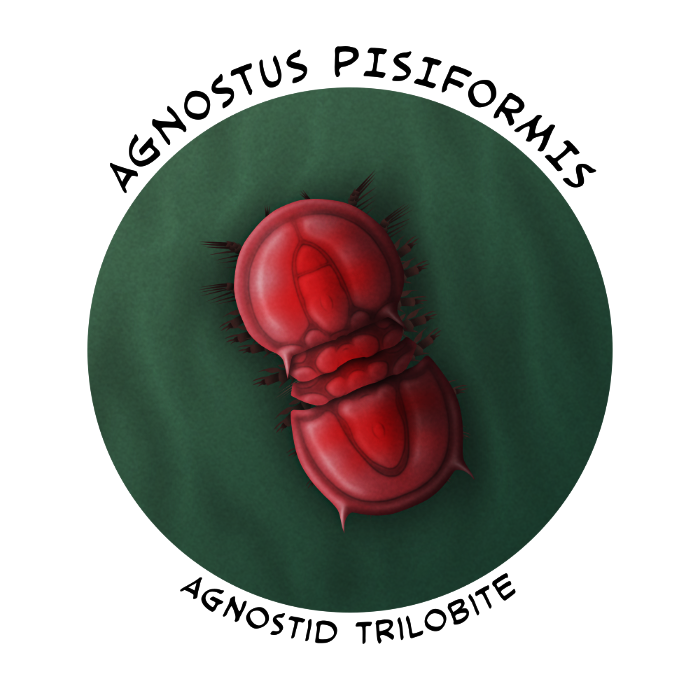Most trilobites were able to roll themselves up into a protective ball – a behavior known as enrollment or volvation – exposing just their heavily armored backs to attackers. They’re often found fossilized curled up like this, and rare preservation of soft tissues shows that they had a complex system of muscles to help them quickly achieve this pose while simultaneously tucking their antennae and all their limbs safely inside their enrolled shells.
Some species also developed sharp defensive spines and spikes that jutted out when they enrolled, making themselves even more daunting to potential predators in one of the earliest known examples of an evolutionary “arms race”.
The agnostids were a group that first appeared in the early Cambrian very soon after the redlichiids and ptychopariids, and lasted until the end of the Ordovician about 444 million years ago. They probably evolved from some of the first ptychopariids*, and were highly specialized compared to other early trilobites, with large head and tail shields that usually looked almost identical, sometimes lacking eyes entirely, and only having two or three thorax segments – showing some convergent similarities to their nektaspid cousins.
( * There’s been some debate about whether agnostids are actually trilobites, or whether they’re closely related “trilobitomorph” artiopodans or even stem-crustaceans that just happened to somewhat resemble trilobites. This is due to soft-tissue preservation revealing limb anatomy that was very different from trilobites and looked more like the legs of crustaceans. But despite some other oddities, like having six pairs of head appendages instead of trilobites’ usual four, the rest of their anatomy still places them firmly as artiopods, and as either trilobites or almost-trilobites.)
Found all around the world mainly in deeper-water environments, agnostids probably spent most of their time crawling around on the sea floor, but they may also have been able to swim in a semi-enrolled posture. They’re also sometimes found preserved sheltering inside the empty hard parts of other animals, such as hyolith shells or Selkirkia tubes.
Some agnostid fossils have been found clustered in large numbers around the remains of other animals, suggesting they may have been opportunistic predators and scavengers, sometimes even cannibalising each other.

Agnostus pisiformis was a typical member of this group, known from the mid-to-late Cambrian (~506-492 million years ago) from sites including Sweden, Siberia, England, Wales, and Canada – widespread and common enough that it can be used as an index fossil to help date rock layers.
It grew to about 1cm long (0.4″), and while its front and back ends looked very similar the tail shield can be identified by a small pair of spines on its outer edge. Despite having only a couple of articulated body segments to work with it was capable of rolling up so its head and tail shield met and fully enclosed its body, forming a pea-sized protective capsule.
The corynexochids were another major group of trilobites to appear in the early Cambrian, descending from early redlichiids. They were one of the longest-lived trilobite lineages, lasting until the late Devonian about 376 million years ago, and often had large tail shields and spines adorning their bodies.

Olenoides nevadensis was a fairly rare species of corynexochid, known from the Wheeler Shale (~507 million years ago) and Marjum Formation (~505 million years ago) in Utah, USA
Up to about 5cm long (2″), it was very spiky for a Cambrian trilobite, with long “cheek” spines, pointy side lobes on its body segments, a row of spines along its back, and four pairs of spines on its tail shield. Like some other early trilobites it wouldn’t have quite been able to roll into a tight ball, instead forming more of a “cylinder” – with its bristling spiny segments protecting its partially-exposed sides, and its tail shield lining up with its head to present an intimidating row of spikes.
